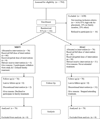Effectiveness of multidimensional family therapy with higher severity substance-abusing adolescents: report from two randomized controlled trials
- PMID: 20873891
- PMCID: PMC4892370
- DOI: 10.1037/a0020620
Effectiveness of multidimensional family therapy with higher severity substance-abusing adolescents: report from two randomized controlled trials
Abstract
Objective: We used growth mixture modeling to examine heterogeneity in treatment response in a secondary analysis of 2 randomized controlled trials testing multidimensional family therapy (MDFT), an established evidence-based therapy for adolescent drug abuse and delinquency.
Method: The first study compared 2 evidence-based adolescent substance abuse treatments: individually focused cognitive-behavioral therapy and MDFT in a sample of 224 urban, low-income, ethnic minority youths (average age = 15 years, 81% male, 72% African American). The second compared a cross-systems version of MDFT (MDFT-detention to community) with enhanced services as usual for 154 youths, also primarily urban and ethnic minority (average age = 15 years, 83% male, 61% African American, 22% Latino), who were incarcerated in detention facilities.
Results: In both studies, the analyses supported the distinctiveness of 2 classes of substance use severity, characterized primarily by adolescents with higher and lower initial severity; the higher severity class also had greater psychiatric comorbidity. In each study, the 2 treatments showed similar effects in the classes with lower severity/frequency of substance use and fewer comorbid diagnoses. Further, in both studies, MDFT was more effective for the classes with greater overall substance use severity and frequency and more comorbid diagnoses.
Conclusions: Results indicate that for youths with more severe drug use and greater psychiatric comorbidity, MDFT produced superior treatment outcomes.
(c) 2010 APA, all rights reserved.
Figures






References
-
- American Psychiatric Association. Diagnostic and statistical manual of mental disorders. 3rd ed., rev. Washington, DC: Author; 1987.
-
- American Psychiatric Association. Diagnostic and statistical manual of mental disorders. 4th. Washington, DC: Author; 1994.
-
- Bauer DJ, Curran PJ. Distributional assumptions of growth mixture models: Implications for overextraction of latent trajectory classes. Psychological Methods. 2003;8:338–363. - PubMed
-
- Del Boca FK, Darkes J. Enhancing the validity and utility of randomized clinical trials in addictions treatment research: I. Treatment implementation and research design. Addiction. 2007;102:1047–1056. - PubMed

